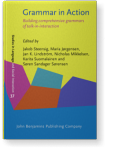Chapter 8
The use of past tense formats in German
talk-in-interaction
The present chapter investigates three frequent German
verbs, finden ‘to find’, glauben
‘to believe’, and meinen ‘to mean’ in first and
third person preterite and present perfect. Prior research on past
tense distribution primarily identifies regional variation as a
driving force (Fischer
2018) or treats preterite and present perfect as
‘interchangeable’ (Helbig &
Buscha 2001). I test these assumptions by investigating a
large corpus of German talk-in-interaction. My findings show that
speakers use lexico-syntactic constructions consisting of past tense
formats and specific grammatical components to implement distinct
actions. Identifying these paste tense constructions, I demonstrate
that tense is not only a ‘traditional’ grammatical category but also
crucial for implementing social actions, thus constituting an
indispensable part of a grammar for talk-in-interaction.
Article outline
- 1.Introduction
- 2.Past tense in German
- 3.Data and methodology
- 4.An interactional approach to past tense
- 5.Past tense formats in German: Constructions with preterite and present perfect to implement social actions
- 5.1Finden ‘to find’
- 5.2Meinen ‘to mean’
- 5.3Glauben ‘to believe’
- 6.Discussion
- 7Conclusion
-
Acknowledgement
-
Notes
-
References
This content is being prepared for publication; it may be subject to changes.
